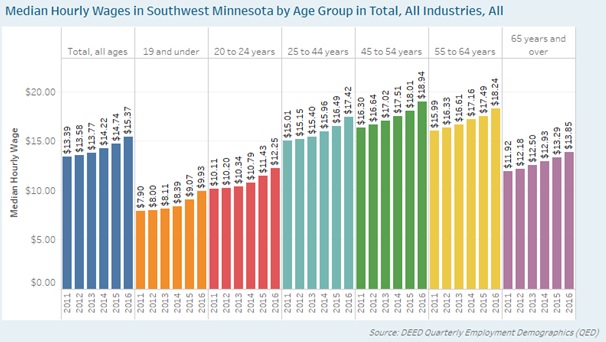 Southwest Minnesota is a national leader in agricultural production, and renewable energy.
Southwest Minnesota is a national leader in agricultural production, and renewable energy.
The region's thriving manufacturing sector includes food processing, machinery, printing, metal products, and computers and electronic products.
Want the freshest data delivered by email? Subscribe to our regional newsletters.
11/17/2017 10:09:32 AM
Luke Greiner
After stagnant wage growth during the recession and recovery, median hourly wages started rising quickly for workers in Southwest Minnesota over the past three years. In fact, median wages rose faster in Southwest Minnesota than the state as a whole from 2011 to 2016, climbing 14.8 percent in the region, compared to a 12.1 percent increase statewide. Overall, median wages jumped about $2.00 per hour since 2011, though the gains varied by age and industry.

Wage growth was especially swift for young workers, who saw their median hourly wage rates swell more than 20 percent from 2011 to 2016. Teenagers saw the fastest jump in pay, from a median of $7.90 per hour in 2011 to $9.93 per hour in 2016. Workers from 20 to 24 years of age also enjoyed rapidly rising wages, ascending from $10.11 to $12.25.
Already the highest earning age group, the largest monetary gain also went to 45- to 54-year-olds, who saw median wages rise by $2.64 from 2011 to 2016, a 16.2 percent increase. Workers from 25 to 44 years and 55 to 64 years also saw sizeable bumps in wages in recent years. This included huge increases in high-paying industries like management of companies, professional and technical services, utilities, and wholesale trade.
While workers in the oldest age groups saw employment gains, wages did not improve as much for people aged 65 years and over. In fact, they saw the smallest median hourly wage increase from 2011 to 2016, rising only $1.93, though that was also a 16.2 percent increase.
DEED’s Quarterly Employment Demographics tool provides data on employment, wages, and hours worked by region and age group. This data set is available for the state, planning regions, economic development regions, and all 87 counties. For a regional look at the data, use this interactive web tool.
Contact Luke Greiner at 320-308-5378 or Mark Schultz.